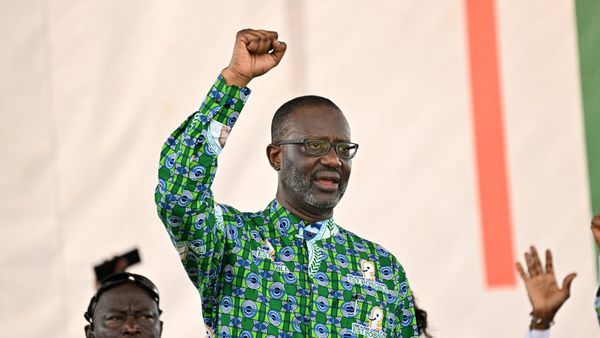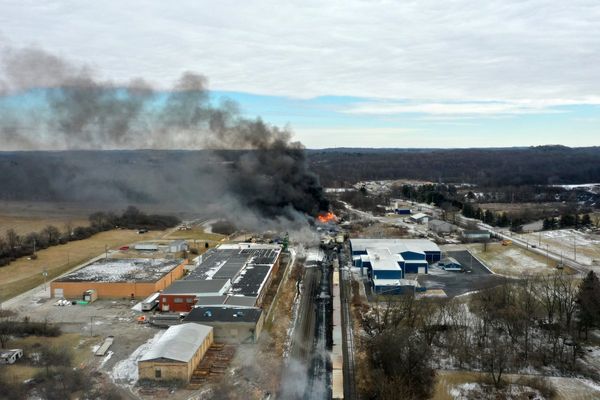
Welcome to Future of Finance, where Fortune asks prominent people at major companies about their jobs, how their firm fits into the crypto ecosystem, and what this all means for how we use money.
Our latest edition is a special 2-for-1 interview with Roger Bayston and Sandy Kaul of Franklin Templeton, who joined me on a video call from Consensus in Austin, Texas, between a few rounds of panel-hopping and swag-schlepping.
Bayston, a 31-year veteran of the firm, now serves as executive vice president and director of quantitative and fintech strategies, while Kaul is a senior vice president focusing on advisory and thought leadership.
Franklin Templeton, which manages about $1.4 billion, just last week announced both a money market fund on Polygon and that its on-chain government-assets-focused fund had surpassed $270 million in AUM.
Deets to follow.
(This interview has been edited for length and clarity.)
Let’s begin with each of you just telling me—and the readers—a bit more about your jobs. Sandy, if you could start?
SK: I have the best job in the world, Justin. I get to think about the future of the investment and wealth management industry, and talk to some of the best people engaged in the industry who are thought leaders all over the world. And then I really synthesize from that: What are the trends that are reshaping things? And then I'm able to bring those learnings into Franklin Templeton, where I'm helping us shape our strategy for our digital asset unit.
Roger, saying you're a Franklin Templeton veteran would probably be a slight understatement at this point, but what drew you to the digital asset space?
RB: Being an industry veteran, as you point out, and a Franklin Templeton veteran as well, I just understood that the management business is full of records. And so we just approach it as how we might be able to use these new technologies to deliver improved efficiencies and services in our existing lines of business, and also how it might be disruptive—which means both challenges as well as opportunities.
That leads a bit into my next question: What else can you tell me about the on-chain government money fund, and the $270 million in AUM? Why was it so important to get that on-chain versus using a more traditional financial instrument?
RB: As we began to explore blockchain technologies in our core business, we identified what might be a proof of concept. We thought working with a money fund would be a good—but difficult—challenge because money funds have historically had a higher level of transaction velocity. Money funds have been used in the transactional economy through debit cards and check writing for a long period of time, and we just thought that if we could [solve] that problem then we could apply our learnings there across the rest of our businesses.
So the plan is to start with that $270 million and go from there?
SK: Yeah, so when you think about the role that money market funds play in the economy, and in the financial ecosystem in particular, there are a number of liquidity use cases that we want to explore. Corporate treasurers use money funds to manage their corporate treasury, investment companies use money funds to hold excess cash and dry powder. People use money market funds in different parts of the world as collateral for trades. So these are all use cases that we want to explore, and we also want to think about how do we create this product to use globally—how do you expand these use cases to other regions in other parts of the world?
RB: Part of that expansion is what we started in 2021. And, you know, working with our great collaborators at Stellar, and using the Stellar public blockchain as part of this background, we see blockchains as kind of...what's the word choice you like to use—
SK: —emerging digital nation states—
RB: —yeah, it’s about how we can deliver inside of these emerging digital nation states, and what other sort of utility there is.
OK, so why Polygon? You could have picked a number of ways to go with that, but what was the deciding factor?
SK: So we were deployed on a layer-1, on the Stellar network, and we really wanted to explore these new layer-2s. And we liked that Polygon is EVM compatible, which gets us to experience [the programming language] Solidity that gets us into other chains as well. I think we just thought there was a good fit, and the people at Polygon were a good fit with our team, and they really hit it off.
We’re seeing more and more traditional financial institutions exploring this space, so what are some of the things you’re maybe doing to stay a step ahead of peers—and help be a leader?
RB: I think it's all about just having a kind of a cultural sort of R&D activity. Again, we started our [blockchain] journey because we wanted to understand how these new technologies might help us expand our customer service, our client service, and how we can deliver better—we’ve learned that there's efficiency gains borne out by the users of our products. And as a result of that, that really unfolded other insights about how public blockchains might be used by other industries. It gave us confidence that this emerging opportunity—sets of tokens from digital nation states—might be able to be wrapped inside of customers' and clients' portfolios as they build the best solutions and outcomes going forward across many asset classes.
SK: We really believe that we can bring our professional investment analysis and advice into this new ecosystem, so we're creating institutional-quality research on the coins that we invest in—we are thinking about the suite of products that would allow us to serve our wealth clients, our institutional clients. We're really thinking about this as another part of what an asset management business needs to be able to deliver to build a holistic portfolio for the future.
How much of this R&D is just your desire to invent and build these products, and how much has been customers saying, “Hey, I’d really like it if you had this”? And what’s the feedback been like?
SK: This is a dialogue. A lot of our customers rely on asset managers who assess the opportunities available to them and help them interpret them, and we’ve also listened to them and think about where they are in their journeys. Some people still only want a private vehicle, like a venture capital fund, but others a little further in their journeys want to experiment with something on-chain. The money market fund is a good chance to experiment with something on-chain. We want to meet the client where they are, and then help them become more educated and comfortable with the space.
Same final question for each of you: What does the 'future of finance' mean to you?
SK: For me, one of the most exciting things about the future is I believe that a lot of assets that have never been part of typical investors’ portfolios—like royalty rights to their favorite artists, like being able to participate in the digital earnings of studios that are putting out great streaming products, being able to identify with their favorite sports teams and favorite sports events—I think that all of these opportunities become opened up as a result of tokenization and smart contracts. I really believe that as we go forward, the investment portfolio that’s going to help me fund my life is also going to become the vehicle that helps me enjoy my life. And that creates a whole new dynamic around how important and central that portfolio is to my day-to-day experience.
RB: Oh, my gosh, how am I going to follow that?
That was a great answer.
RB: [laughs] All I can really say is, if there's one constant in life, it's change. And as Sandy points out, we’re expanding opportunities to improve outcomes for clients. We’re singularly focused on clients and putting clients first—and so we’re just exploring things for their future.







